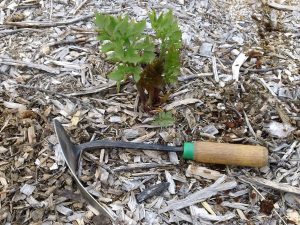Podcast: Play in new window | Download
Subscribe: RSS
Overwhelmed at the prospect of getting started? What are the costs? What tools do I need? I’ll make this as simple as possible: you need a minimum of 5 tools, you need some seeds or transplants, and everything else is free if you know where to look.
Topics covered in this episode
Choose a spot and design for your garden
Check around your land and see where the sun is most prevalent throughout the day. That’s the location where you can best grow your vegetables.
How do you want your garden to look? Do you want wood borders, stone borders, or no borders? The plants don’t care, it’s all a matter of your own preference.
Essential gardening tools
You only need five tools, not counting a wheel barrow.
Ho-Mi Digger (Korean)
Spade Shovel – Find one with a long handle (not a square ended “gardening shovel”). File the edge of the shovel blade to make it easier to use.
Click here for this tool on the Lee Valley website
Rake
Pitchfork – the kind with skinny long tines. The kind you would use for hay. Get one with a long handle.
Pick-axe – will go through anything, good for prying out rocks, very handy tool for breaking up new areas.
Two other general purpose tools that come in handy are a knife and an axe. These are very useful when making or putting in steaks, pegs, pruning vegetable plants, and for cutting string or twine.
Soil
While you can buy bags of soil from your local garden centre or hardware store, there are alternatives available to you. Avoid peat moss as it tends to be acidic and has to be tilled into your soil. The permaculture approach to gardening is a no-till approach. Start with the soil you have. If you have grass, one trick is to cut sods out and turn it over.
Another option is to buy a cubic yard of gardening soil (not topsoil).
You can also find a local horse stable and get some free horse manure. This is probably one of the very best soils to help your garden in terms of it being low cost and high value. The darker the brown the better and the best manure is not in balls. One caution, horse manure is always full of weed seeds, but if you put a few layers of newspaper over it, the weed seeds germinate, hit the paper, and suffocate. The paper will break down on its own in about a month.
If your soil has lots of worms in it, that means it’s good soil as worm manure is the best manure for gardening.
If you are unsure if you soil is good, beans and peas are very forgiving and will often grow well in poor soil. They will also in improve your soil because they have nitrogen fixing bacteria in their root nodules.
Potatoes are a great way to test your soil. If lots of potatoes grow, then you have good soil. If very few potatoes grow, you will need to do something to enhance or improve the nutrients in your soil.
















Awesome tool.